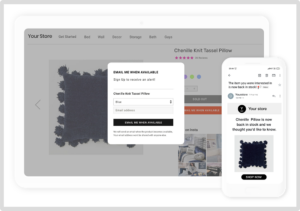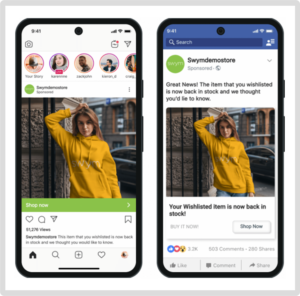Unlocking Ecommerce Success: The Power of Personalized Display Ads
Discover how personalized display ads revolutionize e-commerce, driving conversions and enhancing user experience.
The average person is exposed to somewhere between 6,000 and 10,000 ads a day. If you want to cut through the noise, you need to create ads that resonate directly, and on a personal level.
Enter personalized display ads—the game-changer in driving revenue and enhancing user experience. By tailoring your advertising content to individual shoppers’ preferences, you can skyrocket conversions and leave a lasting impression—personalized experiences by way of dynamic ads can get a conversion rate of 5.43% versus 4.20% for static ads and audiences apparently also browse deeper with dynamic ad respondents viewing 1.77 pages on an average versus 1 page for static ad viewers.
In this blog, we decode the art and science of ad personalization so that you can pick up ideas and drive improved returns on your ad spends.
What Is Personalization In Display Ads?
Personalized display ads allow you to serve highly relevant ad content based on a user’s browsing history, interests, and behavior
Imagine a user named Sarah who spent time browsing summer dresses at an online clothing store, even adding a floral sundress to her cart before leaving without purchasing. With personalized dynamic display ads, the clothing store can leverage Sarah’s browsing data to create a tailored advertising experience just for her.
They can serve Sarah ads featuring the exact sundress she added to her cart, along with similar styles or complementary products like sandals or sun hats. The ads might even include a special discount code or free shipping offer to incentivize her to return to the site and complete her purchase. In fact, 70% of online shopping carts are abandoned, but targeted remarketing campaigns can help you reignite interest. You can also use dynamic retargeting campaigns—which can bring back 26% of those people back to your site—to remind Sarah of the items she left behind in her shopping cart.
Leveraging Shopper Preference Data for Personalization
To unlock the full potential of personalized retargeting, you need to dive into the gold mine of customer data. Data fuels personalized advertising, and it can be collected through various means, such as social media, web analytics, customer data platforms (CDPs), third-party providers, and surveys.
So, what types of data should you be looking at and what kind of personalized advertising should you be creating with it? Here are some essential data points to consider, alongside corresponding ad personalization ideas:
By leveraging data-driven insights, you’ll craft ad experiences that feel like a perfect fit.
Audience Personalization Techniques
With the above personalization measures in place, you can get your message ready to run. However, besides demographic (including geographical) and behavioral targeting that we’ve talked about in the previous section, here are some finer aspects of personalization that you need to cater to as you get your ad out there:
- 🗺️ User Journey Targeting: Guide your audience through the sales funnel with ads tailored to each stage of their journey and move customers closer to conversion. For instance, if a user has recently visited your product page but hasn’t made a purchase, you can serve them an ad offering a limited-time discount to encourage them to take action. AI can also play a role in personalized shopping by dynamically adjusting product page content based on the user’s buying stage.
- 📍 Geo-Targeting: You can use demographic data to serve up location-specific ads that resonate with your audience based on their geographic location.
- 📚 Contextual Targeting: Place your ads in the perfect context to capture your audience’s attention and drive engagement. By aligning your ads with relevant content, you can increase the likelihood of your message being seen and acted upon by interested users. For instance, if you sell kitchen appliances, you could place your ads on popular cooking blogs or recipe websites to reach an audience that is already interested in culinary content.
- 🎛️ Parameter Targeting: Use external webpage parameters to fine-tune your ad delivery and reach the right audience at the right time. By leveraging parameters such as search terms, referral URLs, and UTM codes, you can optimize your ad targeting and improve campaign performance.
How to Implement Personalization
Ready to embark on your personalized display ads journey? Follow these steps:
- 🍰 Segmentation: The foundation of personalization lies in dividing your audience based on relevant criteria like interests, behavior, and demographics. And with our exhaustive guidance in the sections above, you have a ready roadmap to get started with this step.
Creating ad segments on Facebook is a breeze with their intuitive Ads Manager. Simply navigate to the “Audiences” section and click “Create Audience” to define your target segments based on demographics, interests, behaviors, and more. For a step-by-step guide, check out Facebook’s official documentation on creating audiences.
Instagram, as a part of the Facebook family, shares the same powerful segmentation tools. When setting up your Instagram ad campaign, you’ll have the opportunity to define your target audience using the same granular criteria available on Facebook. This ensures a consistent and effective approach to personalization across both platforms. Learn more about targeting options for Instagram ads in this comprehensive guide.
To take your segmentation to the next level, consider integrating data from Swym or other sources to inform your marketing. Swym captures valuable signals about customer preferences. Discover how to harness the power of Swym’s data with these handy playbooks.
- 🎨 Ad Customization: After ID’ing your segments, craft tailored ad creatives that speak directly to each segment’s unique preferences and context For example, if you are serving an ad to a back-in-stock subscriber who has asked to be notified when you restock a “high neck red t-shirt” you might serve them an ad of other red t-shirts that share style, texture and other similarities with the out-of-stock product.
Or serve an ad about another discount offer to a customer who first landed on your site for a discount offer
Facebook’s Advantage+ dynamic ads are a game-changer for personalization. These ads automatically adapt to showcase the most relevant products or offers based on each user’s behavior and interests. Learn more about Advantage+ dynamic ads here.
- 🌐 Dynamic On-Page Advertising: Want to be the best? Learn from the best—Amazon, a pioneer in personalization, attributes 35% of its revenue to its recommendation engine, which heavily relies on dynamic advertising. Incorporate dynamic elements like product recommendations and real-time pricing to create a sense of urgency and relevance. Use live data and analytics to select the most relevant ad creative for each user through Dynamic Creative Optimization (DCO).
Swym’s product recommendation engine is a powerful tool for enhancing the on-page experience. When a user clicks through from your personalized ad and lands on your website, Swym can dynamically display products they’ve previously interacted with, such as items they’ve added to their wishlist or recently viewed. With Swym, you can create a seamless experience that keeps users engaged throughout their shopping journey. Explore Swym’s Product Recommendation feature to learn how it can boost your personalization efforts.
- 🧪 A/B Testing: Continuously optimize your ads by testing different variations and analyzing performance metrics. Tools like Adobe Target and Google Analytics 4 allow you to create and test multiple ad variations based on user profiles, ensuring that you deliver the most relevant and engaging content to each segment.
To streamline your A/B testing efforts, consider leveraging powerful tools like Google Optimize or Optimizely. These platforms provide an intuitive interface for creating and managing test variations, as well as robust analytics to help you make data-driven decisions. Check out these comprehensive guides to get started:
- Hubspot: A/B testing kit
- Optimizely: A/B Testing with Optimizely
Measuring Success
To gauge the impact of your personalized display ads, keep a close eye on these key performance indicators:
- 🖱️ Click-through Rate (CTR): Measure how often users click on your ads. Expert Tip: Aim for a CTR above 0.5% for display ads, and continuously monitor and optimize your campaigns to improve this metric.
- 💰 Conversion Rate: Track the percentage of ad clicks that lead to desired actions, such as purchases or sign-ups. Industry benchmarks suggest a conversion rate of 2-3% for e-commerce, but personalized ads can significantly boost this figure.
- 📈 Return on Ad Spend (ROAS): Evaluate the revenue generated in relation to your advertising costs. A ROAS of 4:1 or higher is considered ideal, meaning for every dollar spent on ads, you generate $4 in revenue. Personalized ads can lead to higher ROAS by providing a more relevant experience.
- 📊 Engagement Metrics: Monitor metrics like view rate, average watch time, and shares to assess how well your ads resonate with your audience. High engagement rates indicate that your personalized content strikes a chord with viewers.
- 🔍 Brand Lift: Measure the impact of your ads on brand awareness, consideration, and intent. Personalized ads can significantly boost these metrics by creating a memorable and relevant brand experience.
Pro Moves For Making Personalization More Effective
Personalization need not just be from the customer’s perspective, you can also create expanded audience segments that are personalized to your brand.
Here’s how:
- 🎯 Audience expansion: Leverage lookalike audience features that let you reach new potential customers who share characteristics with your existing customer base. Platforms like Facebook, Google, and LinkedIn offer lookalike audience expansion features that allow you to target users who are likely to be interested in your products or services based on your existing target segments. For example, if you have a segment of high-value customers who frequently purchase from your online store, you can create a lookalike audience based on their characteristics to find new prospects who are likely to convert.
Example of an ad targeting a user that resembles an existing audience
Similarly, you can also target affinity audiences to reach users who have demonstrated a strong interest in topics related to your products or services. Affinity audiences are predefined by Google, based on users’ browsing history, search behavior, and interests. For instance, if you offer eco-friendly clothing, you can target affinity audiences like “Green Living Enthusiasts” or “Sustainable Living Enthusiasts” to reach users who have shown a strong interest in environmental topics.
- 🌟 Influencer Marketing: Leverage the power of influencers to introduce your brand to their engaged followers. Identify influencers whose audience and values align with your target market and collaborate for sponsored content, product reviews, or social media takeovers—this content can also be repurposed into ads. Influencer partnerships can help you tap into new audience segments, increase brand awareness, and drive conversions.
When selecting influencers, consider their engagement rates and content quality to ensure a successful collaboration. For example, a sustainable fashion brand can partner with a popular Instagram influencer known for promoting eco-friendly lifestyles. The brand can serve personalized ads to their followers around “Your favorite influencer’s most-loved sustainable styles” and showcase products from their line-up. Similarly, you can also collaborate with industry experts. Consider the example of a health food company collaborating with a nutritionist to serve ads to the followers of the nutritionist where he or she endorses the brand.
The Final Wrap: Tying It All Together with a Personalized Ribbon 🎀
In the competitive e-commerce landscape, personalized display ads are your secret weapon to stand out and drive conversions.
By harnessing the power of data, ad customization, dynamic advertising, and continuous optimization, you’ll create a shopping experience that feels nothing short of magical. Embrace personalization, and watch your revenue soar!
People also ask (FAQs)
Q: What are personalized ads?
Personalized ads are advertisements tailored to individual users based on their browsing behavior, interests, and demographics.
Q: What is a display ad example?
A display ad example is a banner showcasing a specific product a user has previously viewed on an e-commerce site.
Q: What is the difference between personalized and non-personalized ads?
Personalized ads are customized for each user, while non-personalized ads are generic and shown to a broad audience.





